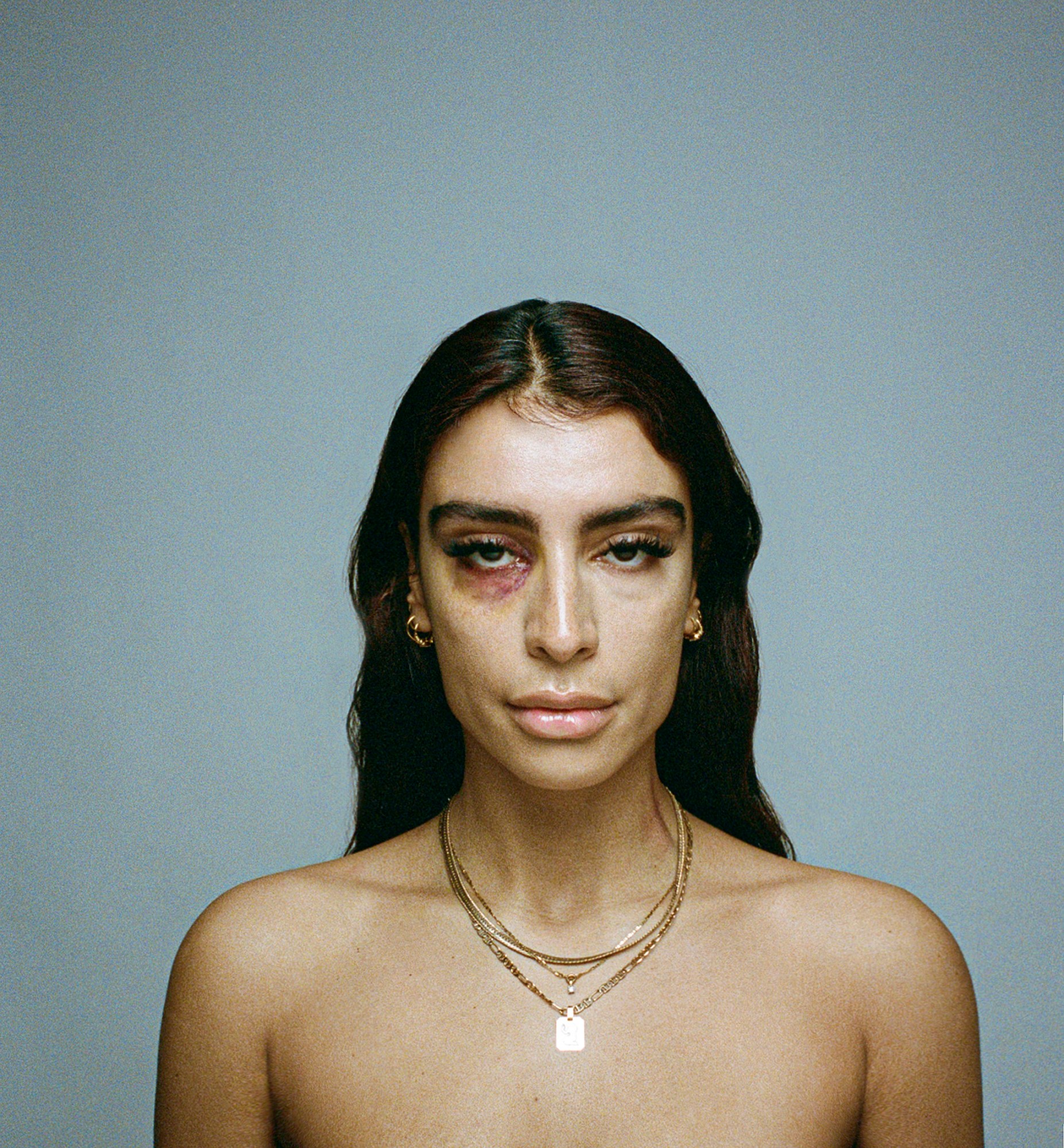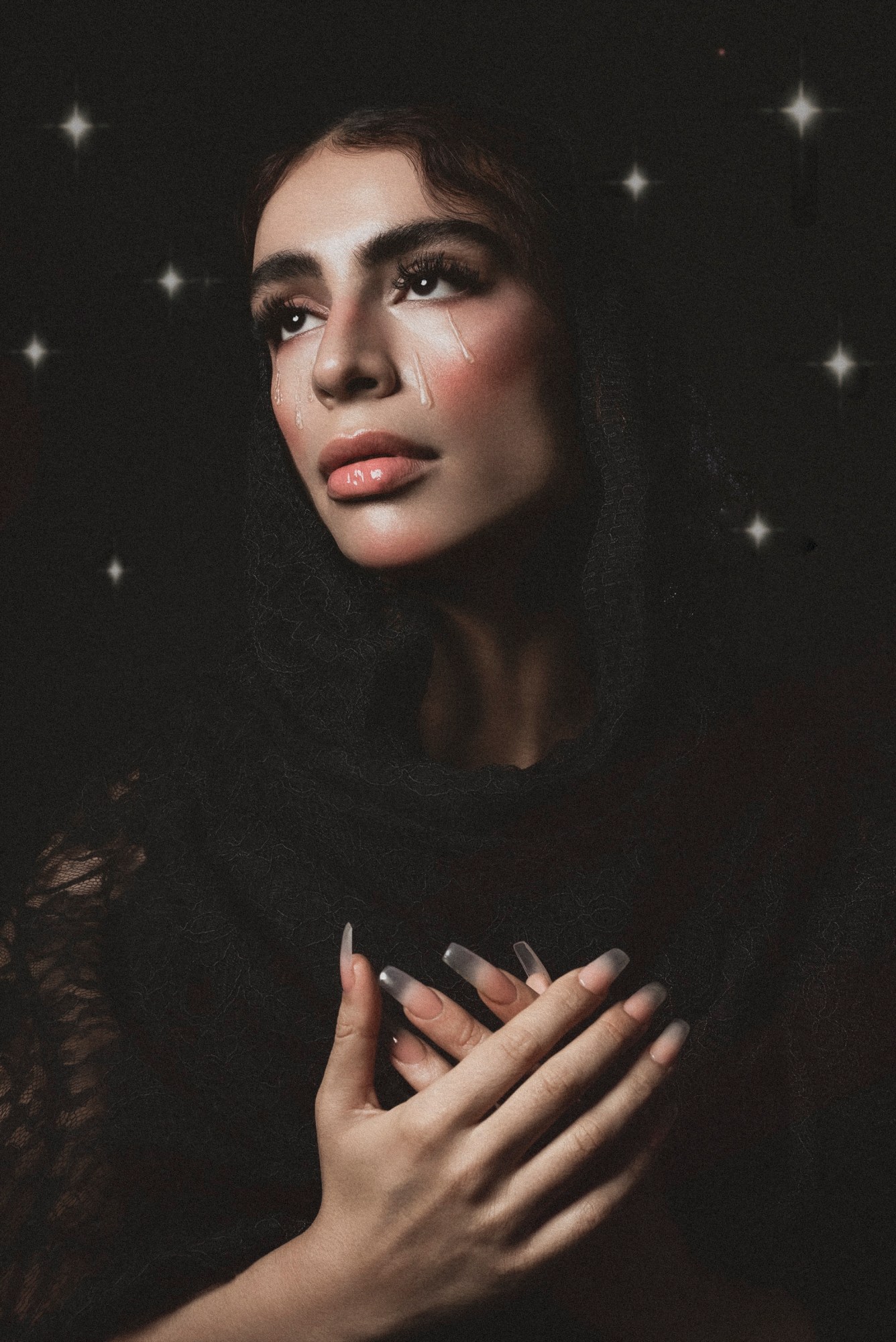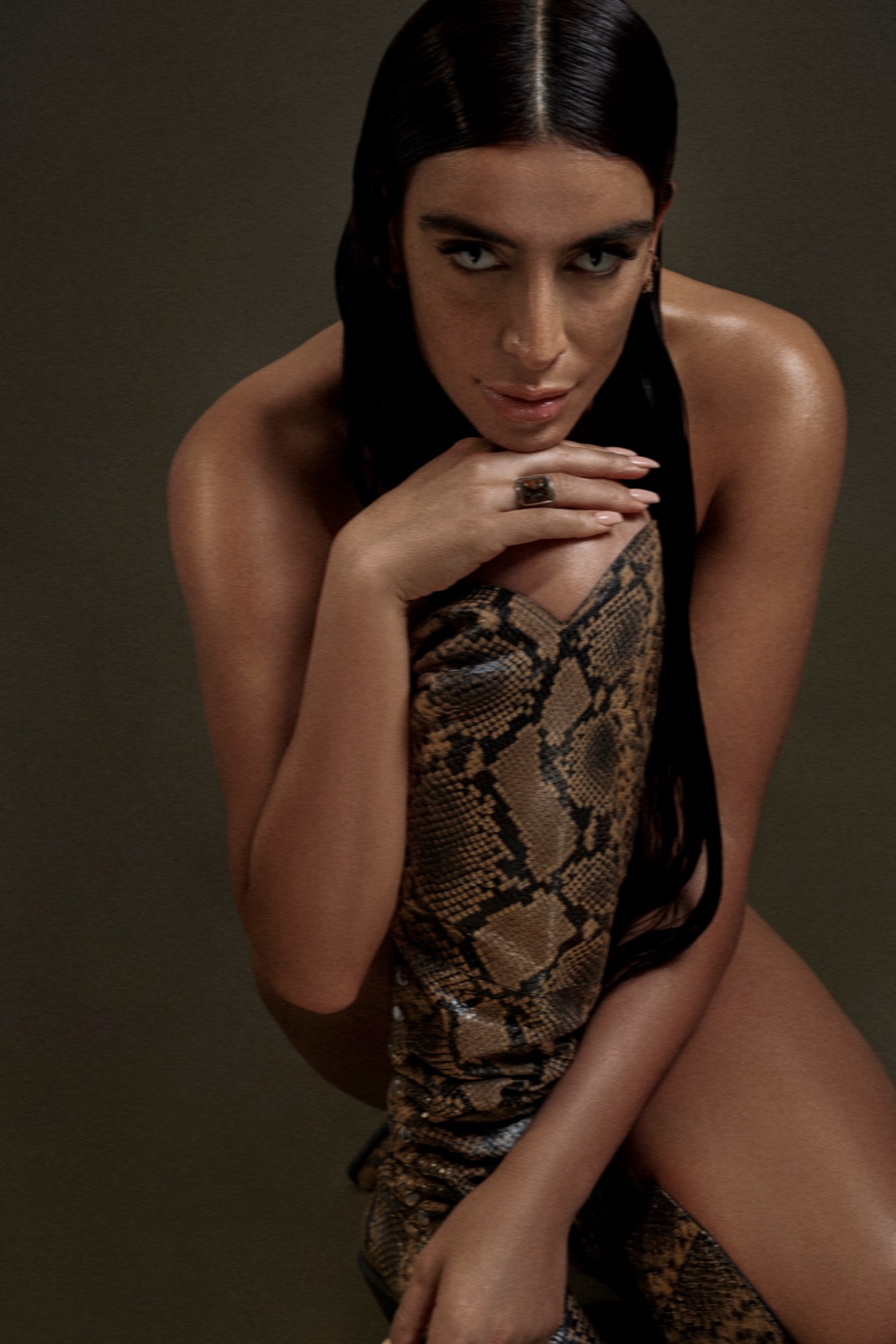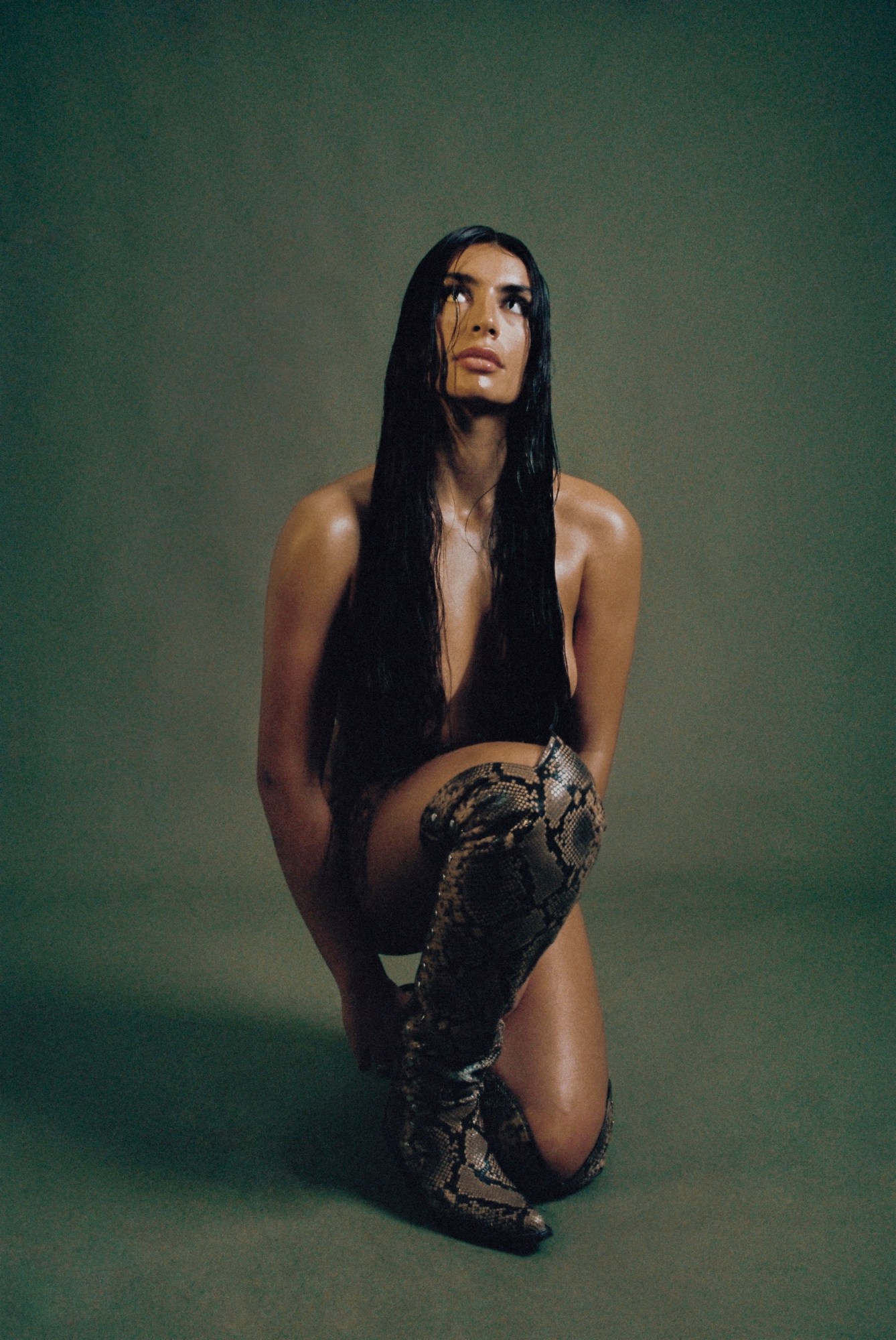On the cover of Sevdaliza’s new album Shabrang is a portrait of her with a black eye (on the reverse side of the LP is a photo of bruising around her neck). At first glance, it looks a lot like an image taken after a 911 call, but according to the Iranian-Dutch autodidact it was an abstract choice that she arrived at after seeing patterns emerge within her subconscious. The title, Shabrang, emerged this way too, as did the title of her 2017 debut album ISON, and its womb-coloured cover art created by the artist Sarah Sitkin. It depicts a mould of Sevdaliza’s face inverted on top of a sculpture.
Such abstract metaphors can be found throughout Sevdaliza’s existential pop music. The colours in her black eye are linked to the Persian word Shabrang, which means the colour of the night sky. These colours are represented in the music by ten key themes: abuse, narcissism, substance abuse, death, heartbreak, abandonment, despair, mental health, love and passion.
“It is a deep love letter to myself,” Sevdaliza says in a statement about the album. “Shabrang is a depiction of functioning in my soul, like watching life happening in front of you and not for you. Always trying to return to the light, I shift between hope, faith and fear/dystopia. I feel privileged yet misunderstood. The underdog.”

“I think that this record chose me,” she says triumphantly over the phone from Amsterdam, after a day out at the newly reopened Bonnefanten Museum in Maastricht. “[Shabrang] showed me that life is so much richer than the narrative that we have for ourselves… and it’s so abstract. That’s why I love art so much. It’s the abstract and the subconscious, the thing that you cannot necessarily describe, but it gives you a certain feeling.”
Sevdaliza officially announced the album in late July, but by that time she had already delivered three gorgeous, soul-searching singles, “Oh My God”, “Lamp Lady” and “Joanna.” Billie Eilish even declared herself a fan.
The first single, “Oh My God,” alludes to the ongoing economic war between the US and Iran, and the politicisation of her national identity. In the song — an avant-pop number with downpitched vocals, deep bass and trap-inspired high hat bursts — she repeats the phrase “Oh my god/ Who should I be?/ What is it you want when you come for me?” occasionally pitch-shifting her voice to mimic the accent of a valley girl. The accompanying visual, which contains home videos of her dancing in a school play and receiving her first keyboard as a birthday present, tears down the stereotypes that are often used to portray people from the Middle East.

“Joanna,” the opening track on Shabrang, was released three months ago and is one of the most vulnerable pieces of music Sevdaliza has released thus far. In May, she wrote on Instagram that it was written during one of her darkest periods, and in a statement released with the song she described it as a “universal story of unrequited love. A reflection of the unbearable suffering crawling into our lives in different shapes.” The video shows Sevdaliza in her most fragile form; dressed as a wounded black swan with blood dripping from her nose, and in a wig cap with only her bare shoulders showing.
One of the most intriguing, yet to be unveiled moments on Shabrang, is a reworking of the Persian pop song “Gole Bi Goldoon” — originally written and recorded in 1974 by the celebrated Iranian singer and actress Googoosh. Sevdaliza has stated in the past that she is not directly influenced by Persian pop music because she has never really listened to it (she spent only a few years of her childhood in Tehran, before moving to the Netherlands at age five), which makes her decision to cover the song all that more interesting.
Asked if she has any connection to the Googoosh song, Sevdaliza explains mysteriously, “It has a very strong attachment to certain moments in my life, and not always moments that I wanted it to.” Unlike the original version, which is paced like a traditional pop song and uses botanical metaphors to explain the risk of placing your trust in an unfaithful lover (some have connected this theme to the failed promises of the Iranian Revolution), Sevdaliza’s sparse rendition, made with only a piano and violin accompanying her, emphasises the feelings of abandonment and heartbreak that are contained within the song’s fervent lyrics.
Persian cues are certainly becoming more noticeable within her music. She once had a conservatory professor say that he could hear various Persian semi and microtones when she sings, and others have commented beneath the music video for “Joanna” that they also hear traditional vocal runs throughout. Sevdaliza has also noticed this side of her identity becoming more prominent. “I see more and more influences that are naturally placed,” she says. “If I had grown up listening to this type of music then it would make more sense. But I didn’t, it’s just something that is inside of me. I think there’s this DNA which is ingrained in your being, and sometimes when I’m doing stuff, I feel that a part of me is channeling that.”
“In the way that I write, I definitely feel connected to Persian poetry,” she continues. “Every Persian poet that has ever been famous has this existentialism around their writing, and I really relate to that. It comes through in a lot of things that I write and create, and I feel like that must come from my heritage.”
Premiering today on i-D is the music video for “Habibi,” which was written, produced and directed by sevda+ana, a new creative directing duo formed by Sevdaliza and the Russian filmmaker Anastasia Konovalova. It is the album’s final single and arrives just a few days before Shabrang officially drops on August 28. Soon the duo plan to direct visuals separate from Sevdaliza’s work, but the “Habibi” video is their collaborative directorial debut.

The video begins with Sevdaliza pointing a pistol at the head of a dog (a reference to her explosive state of mind) then follows her as she charges through a forest and walks around the grounds of a tower, passing by different characters. In a note to i-D, the duo explain, “The forest represents Sevdaliza’s emotions: the frustration, fear and anger that every person has during their journey. The tower represents Sevdaliza’s reality and the people she encounters throughout her life. Although she comes face-to-face with these characters, she remains invisible to them all, except one — the older woman. The older woman is an older version of Sevdaliza and represents the end of her (everyone’s) life.”
In past videos Sevdaliza has happily used her body as a canvas, and again, what’s most striking about this black and white visual is just how much power is extracted from the human form. The video’s message, Sevdaliza tells us, is to not define yourself through other people, but to learn from the experiences you have with people and define yourself alone.
Sevdaliza will perform a special show called “Colors of the Night” at the historic Royal Theatre in The Hague on August 31, which will stream globally. Tickets are available here.
